This is taken from Dr. John Pepino's article in Memento put out in April 2017 by the Priestly Fraternity of St. Peter:
Read more >>
Easter is the "most blessed day of ours!" North African Bishop Commodian exclaimed in the 240s AD. What light do the Fathers of the Church shed on the meaning of this feast?Regardless of the name used, the celebration of our Lord's Resurrection on Easter/Paschua is the greatest celebration in the Christian year. No one who claims to be a follower of Christ can not celebrate it. The apostles themselves instituted the annual celebration to commemorate our Lord's Resurrection and themselves instituted a fast (which we call Lent in English) to prepare for it.
St. Bede, writing in eight-century England, reports that "Easter" is derived from the Anglo-Saxon name for April, Eostur-monath, named after their goddess Eostre, the patroness of the dawn or the spring. The Latin term Pascha (From which comes the term paschal candle), taken over unchanged from the Greek derives from the Hebrew word for the Passover, Pasah. The meaning of these words is worth pondering in our preparation for Easter.
First, Easter: Bede indicates that the retention of the pagan name brought with it no connotation of the old religion; now Christians, Englishmen "call the joy of a new solemnity (Easter) by the word they used to in the old religion" (On the Reckoning of Time 15). There is no more paganism left here than in the names of weekdays or months (Thursday for Thor, January for Janus, etc.). For Bede, the predominant meaning of Easter is joy.
Pascha conveys a number of meanings, all connected to Easter. The early Christian writers of Alexandria, Egypt focused on the Resurrection of Our Lord as a fulfillment of the Passover of the Jewish people through the Red Sea and ultimately into the Holy Land. Our joy is in passing from death to life through Baptism as well as in partaking of the feast of the slain Passover Lamb in Holy Communion, as we "pass over from the things of this life to God" (as third-century writer Origen wrote in Against Celsus 22). The dominant note here is of movement: from slavery to freedom, from darkness to light, and from the world as it is now to paradise restored after the Resurrection of the Dead. The Old Testament readings of the Vigil Mass, particularly the twelve lessons in the traditional Easter Vigil, recall and develop this theme.



.jpg)





































